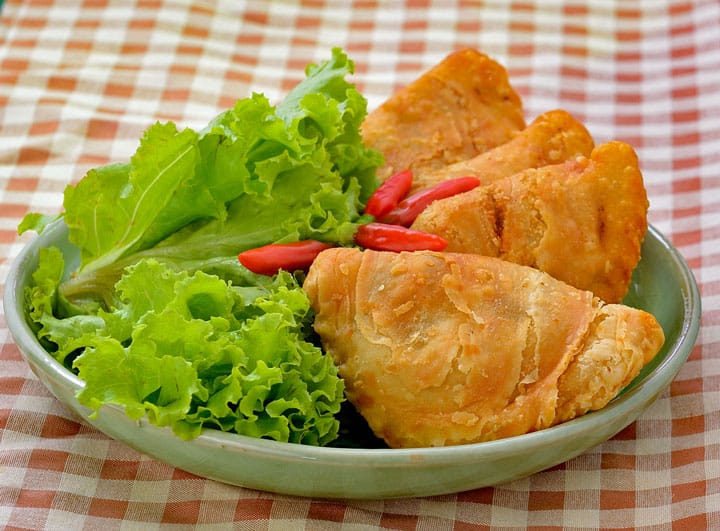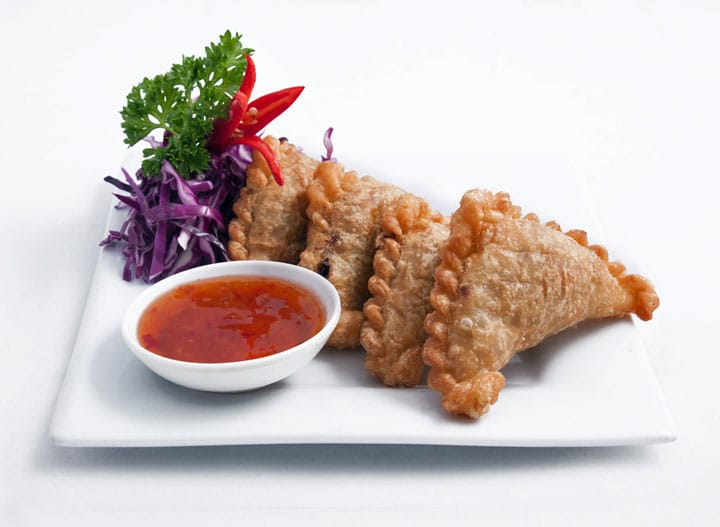You've probably heard of dim sum, sushi or spring rolls, but have you ever heard of karipap? This delicious and often underrated delicacy is native to Southeast Asia and has made its way to different parts of the world over the years. Today it is one of the most popular snacks in the region.
The Thai term กะหรี่ปั๊บ is pronounced phonetically as “ka-ri-pab”. Keep in mind that pitch is very important in Thai, and this is a basic phonetic representation. In the International Phonetic Alphabet (IPA), the Thai term กะหรี่ปั๊บ is rendered /kà-rìː-páp/. Note that Thai is a tonal language, so the tones are important. In this transcription, a falling tone is represented by a grave accent (`) on the first syllable (kà), a midtone with a macron (ː) on the second syllable (rìː), and a high tone is represented by an acute accent ( ´) on the third syllable (páp).
What is karipap?
Karipap, also known as 'curry puff' or กะหรี่ปั๊บ in Thai, is a type of pastry filled with a delicious filling. The filling usually consists of potatoes, meat and vegetables, all seasoned with a blend of spices that create the unique, distinctive taste of karipap. It's a handy snack that you can take with you on the go, warm up for a quick snack or serve as an appetizer to a festive meal.
The origin and history of karipap
The exact beginnings of karipap are difficult to trace. Some sources suggest that it originated in Malaysia and Singapore in the 19th century through the influence of British culture, as karipap resembles the Cornish pasty from England. Others believe it to be of Indian origin, especially from the samosa, a similar pastry with a spiced filling.
Whatever its exact origins, karipap has evolved over the years into a beloved snack throughout Southeast Asia, from Malaysia and Singapore to Thailand and Indonesia. Each country has created its own unique version of the snack, varying in shape, size, crust texture and filling. Ingredients and flavor profile of karipap
A typical karipap has a light golden brown, crispy crust with a soft and tasty filling. The filling traditionally consists of potatoes, meat (usually chicken or beef) and sometimes vegetables such as carrots or peas. All this is seasoned with a blend of spices, including turmeric, chilli powder, cumin and coriander, which combine to create a rich, spicy and slightly spicy taste.
Make your own karipap at home
Feel like diving into the kitchen yourself and making this delicious snack? Here's a simple recipe for four people.
Ingredients
For the dough:
- 250 grams of flour
- 120 grams of butter
- 1 / 2 teaspoon of salt
- 100 ml cold water
For the filling:
- 2 large potatoes
- 200 grams of chicken breast
- 1 large onion
- 2 cloves garlic
- 1 teaspoon of turmeric
- 1 teaspoon chili powder
- 1/2 teaspoon cumin
- 1/2 teaspoon coriander
- Salt and pepper to taste
- 2 tablespoons of oil
Preparation
- Start with the filling: cut the potatoes and chicken breast into small cubes. Chop the onion and finely chop the garlic.
- Heat the oil in a pan and add the onion and garlic. Fry this until the onion is translucent.
- Add the potatoes and chicken and cook until the chicken is cooked through and the potatoes are soft. Add the spices, salt and pepper and stir well.
- While the filling is cooling, make the dough: mix the flour and salt in a large bowl. Add the butter and mix until the mixture is crumbly. Then slowly add the water until you have a firm dough.
- Divide the dough into equal portions and roll out into thin circles. Place a spoonful of the filling in the center of each circle.
- Fold the circles in half to form half moons and press the edges closed tightly. You can also braid the edges for an extra beautiful result.
- Bake the karipap at 200 degrees Celsius for about 20-25 minutes, or until golden brown.
And there you have it, your very own homemade karipap! It's a simple yet satisfying recipe that you should definitely try.
Enjoy!




“…a descending tone represented by a grave accent (`) on the first syllable (kà), a mean tone with a macron (ː) on the second syllable (rìː)…”
This explanation is incorrect. The tone mark ` indicates low tone. I suspect that the : indicates that it is a long i sound. There are no falling and middle tones in this word.
กะหรี่ปั็บ is indeed low, low, high tone and short, long, short vowel. The kari spelled this way also means 'whore'.
And then you also have the ปุ๊ pronunciation 'poo', also with a high tone. for example in the sentence:พอนอนหลับปุ๊บก็ฝันปั๊บ pho nohn lab poop ko fan pap. 'As soon as I fall asleep I start dreaming'.
Well, displaying the phonetics remains a problem because it can be done in various ways. In the English phonetic representation, the difference between short and long vowels often disappears… I would write the dish in Dutch phonetics as follows: กะหรี่ปั๊บ –> kà-rìe-páp (low-low-high). Possibly kà-rìe:-páp , with indeed an een : to indicate a long vowel.
The best thing is of course learning to read yourself, for example with my previous blogs here:
https://www.thailandblog.nl/taal/het-thaise-schrift-les-1/